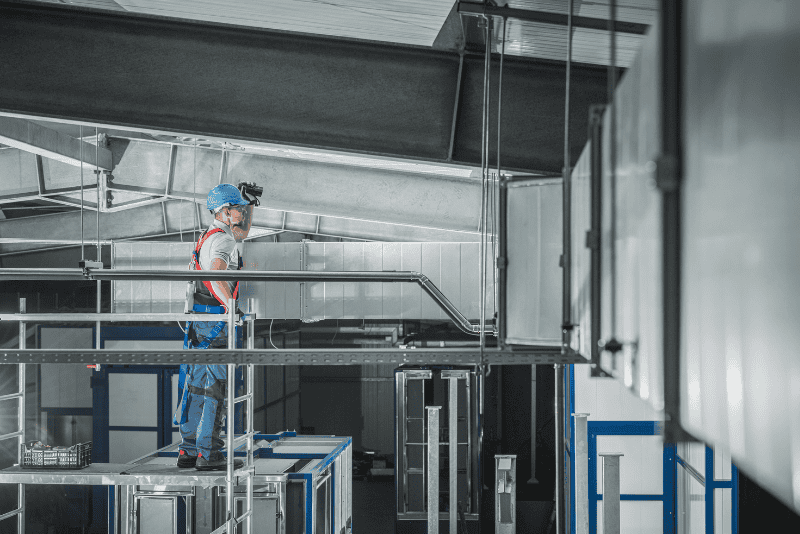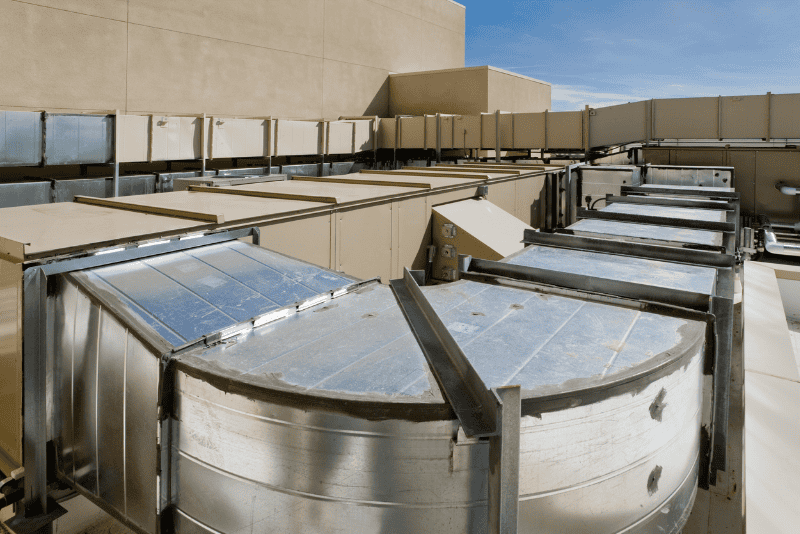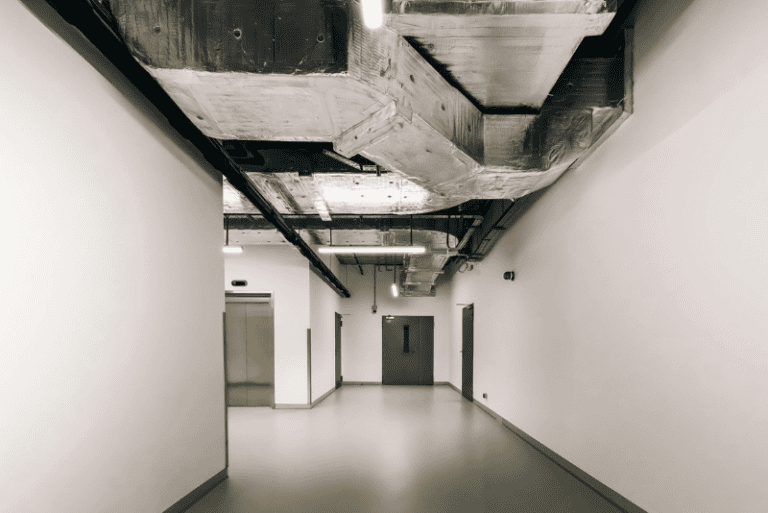Ever walked into a building and instantly noticed how cool or warm it feels, without a clue where that comfort comes from? That’s the magic of HVAC systems. But what is commercial HVAC ductwork, and why should business owners or facility managers care?
If your office feels stuffy in one room and freezing in another, the culprit may be hiding above the ceiling tiles, your ductwork. Understanding what commercial HVAC ductwork is and how it works can help you avoid inconsistent temperatures, high energy bills, and frequent maintenance calls. This guide breaks it all down in simple terms, helping you make smarter decisions for your building’s comfort and efficiency.
What Is Commercial HVAC Ductwork?

Commercial HVAC ductwork refers to the system of metal or flexible tubes that transport air, heated, cooled, or ventilated, throughout a commercial building. It acts as the “highway” for your heating, ventilation, and air conditioning (HVAC) system, delivering air to and from various spaces, such as offices, conference rooms, or warehouses.
In short, it’s not just about blowing hot or cold air; it’s about doing it efficiently, evenly, and safely.
Why Proper Ductwork Matters in Commercial Buildings
When ductwork is well-designed and properly installed, it ensures that:
- Every room receives the right amount of airflow
- The HVAC system runs efficiently and uses less energy
- Indoor air quality stays safe and consistent
Poor ductwork, on the other hand, can cause:
- Hot and cold spots
- Increased energy costs
- More wear and tear on your HVAC system
- Unhealthy air circulation
Key Components of Commercial HVAC Ductwork
A typical commercial duct system includes:
- Supply ducts – push conditioned air into different rooms
- Return ducts – pull air back to the HVAC unit to be reconditioned
- Vents and registers – the openings where air enters or exits rooms
- Dampers – help regulate airflow and balance temperatures across zones
Ducts may be made from sheet metal, fiberglass-lined materials, or flexible plastic. The right choice depends on your building’s size, layout, and air needs.
Common Types of Commercial Ductwork Systems
Here are a few setups you might see in commercial spaces:
- Single-Zone Systems – great for smaller buildings with uniform temperature needs
- Multi-Zone Systems – ideal for larger buildings with varying room usage
- VAV (Variable Air Volume) – offers precise airflow control and energy efficiency
- CAV (Constant Air Volume) – maintains steady airflow, best for spaces with consistent needs
Each has its pros and cons, but a commercial HVAC contractor can help you choose the right system for your space.
Maintaining Your Commercial HVAC Ductwork
Even the best duct system needs routine care. Here’s how to keep things running smoothly:
- Get regular inspections (at least once a year).
- Seal leaks to prevent energy loss.
- Clean ducts to reduce dust, allergens, and mold.
- Replace filters regularly to protect air quality and system performance
- Building occupants can also play a role in maintaining healthy indoor air by following best practices recommended by the EPA.
Neglecting duct maintenance can result in higher costs in the long run, not just financially, but also in terms of employee comfort and building safety.
How Commercial HVAC Ductwork Is Designed

Designing commercial HVAC ductwork isn’t just about connecting a few tubes; it’s a strategic process that ensures air moves efficiently and safely throughout your building.
Building size and layout
Larger spaces or multi-floor buildings require zoning and precise duct routing to ensure even airflow.
Airflow demand
Engineers perform load calculations to determine how much air needs to be delivered to each room based on occupancy, usage, and equipment.
Zoning requirements
For buildings with different room functions (e.g., server rooms vs. break rooms), separate zones with individual controls are designed into the system.
Compliance with codes
Commercial duct systems must meet local building codes and energy efficiency standards, like ASHRAE or SMACNA guidelines.
Well-designed ductwork minimizes pressure loss, balances temperatures across zones, and supports HVAC system longevity.
Choosing the Right Materials for Your Ductwork
Not all ductwork is created equal. The material you choose directly impacts durability, noise, air quality, and energy efficiency.
Sheet Metal (Galvanized Steel or Aluminum)
Pros: Durable, fire-resistant, long-lasting
Cons: Higher installation cost and requires insulation
Best for: Most commercial spaces
Fiberglass Duct Board
Pros: Built-in insulation, absorbs sound
Cons: Can trap dust or degrade if not maintained
Best for: Offices, small commercial buildings
Flexible Ducts (Plastic & Wire Coil)
Pros: Easy to install in tight spaces, cost-effective
Cons: Less durable, prone to kinks, and airflow resistance
Best for: Add-ons or retrofits in low-pressure systems
Don’t Skip Insulation
Insulated ductwork helps prevent energy loss, reduces condensation (which can lead to mold), and keeps air temperatures consistent from unit to vent. Even if your material has built-in insulation, adding or upgrading insulation can improve energy efficiency and reduce long-term operational costs.
Common Ductwork Problems and Quick Fixes
Even the best duct systems can run into problems now and then. The good news? Many issues are easy to spot and fix if you know what to look for.
Here are some common headaches:
- Air leaks: If your ducts have cracks or holes, the air you paid to heat or cool just slips away, which means uneven temperatures and higher bills.
- Poor insulation: Without proper insulation, your ducts lose heat in the winter and gain heat in the summer, making your system work overtime.
- Dirty or clogged ducts: Dust, debris, or even mold can build up inside ducts, making the air feel stuffy and unhealthy.
- Wrong duct size or layout: If the ducts aren’t sized or routed correctly, some rooms get too much air while others barely get any.
- Broken dampers or vents: When these don’t work right, airflow can get blocked or unbalanced, causing discomfort.
Quick tips to fix things:
- Check your ducts regularly for leaks or damage.
- Seal any gaps with duct mastic or metal tape (not regular duct tape).
- Get your ducts professionally cleaned if you notice dust or musty smells.
- Make sure vents and dampers open and close smoothly.
- If you’re still noticing hot or cold spots or strange noises, call in an HVAC pro to take a look.
Energy Efficiency and Cost Savings
Good ductwork isn’t just about comfort; it’s one of the best ways to save on your energy bills.
Why it’s important:
- Less wasted air: When ducts are sealed and insulated well, you don’t lose hot or cold air along the way.
- Even airflow: Proper design means every room gets just the right amount of air, no overcooling or overheating.
- Lower bills: An efficient system doesn’t have to work as hard, so your utility costs go down.
- Longer system life: When airflow is balanced, your HVAC equipment doesn’t wear out as fast, saving you repair costs.
How to save the most:
- Seal and insulate ducts; it’s worth the upfront investment.
- Keep up with regular maintenance to avoid surprises.
- Use programmable thermostats to control different zones easily.
- Thinking of upgrades? Ask your contractor about energy-efficient duct materials.
Conclusion
Commercial HVAC ductwork plays a big role in keeping buildings comfortable and energy-efficient. Understanding how it works and maintaining it well can help you avoid temperature problems, save money on energy bills, and improve indoor air quality. Whether you manage a small office or a large facility, taking care of your duct system is a smart step for long-term comfort and savings.
If you want to learn more or improve your building’s HVAC, consider reaching out to a professional to evaluate your ductwork and keep things running smoothly.



